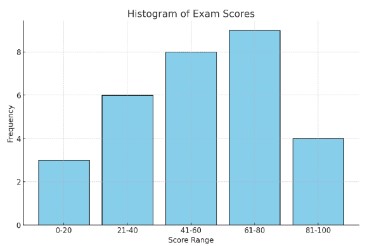Lesson Example Discussion Quiz: Class Homework |
Example |
Title: Statistics |
Grade: Best-SAT3 Lesson: S8-P2 |
Explanation: The best way to understand SAT-3 is by looking at some examples. Take turns and read each example for easy understanding. |
Examples:
Applying the IQR Method to Identify Outliers in Concert Ticket Prices.
Concert ticket prices: 75, 60, 80, 90, 65, 70, 85, 95, 70, and 100
Step 1a
|
|
75, 60, 80, 90, 65, 70, 85, 95, 70, and 100 Q1 (First Quartile) = 70 \$"Lower Bound" = "Q"1 − 1.5 \times "IQR"\$ \$"Upper Bound" = "Q"3 + 1.5 \times "IQR"\$ |
|
Explanation: Here, we find Lower bound and Upper bound and IQR. |
|
Step 1b
|
|
Any data point below 40 or above 120 is considered an outlier. In this dataset, all data points are within the bounds of 40 and 120. |
|
Explanation: Here, we identify outliers. There are no outliers in the given data. |
|
The following table represents the exam scores (out of 100) of 30 students in a class:

Create a histogram to represent the frequency distribution of the exam scores.
Step 2a
|
|
X-axis = Score range, Y-axis = Frequency |
|
Explanation: Here, we draw the x-axis, and y-axis and drawbars to represent scores based on their frequency. |
|
Step 2b
|
|
|
|
Explanation: Therefore, the histogram provides a visual representation of the distribution of scores, making it easy to see which score ranges are most and least common in the class. |
|
Copyright © 2020-2022 saibook.us Contact: info@saibook.us Version: 1.5 Built: 09-October-2024 09:20AM EST
